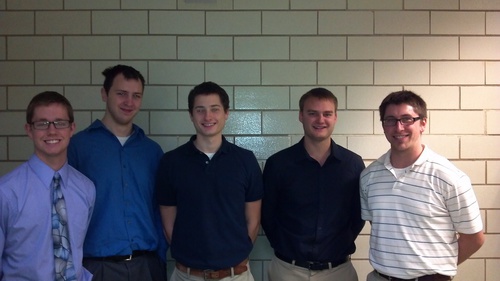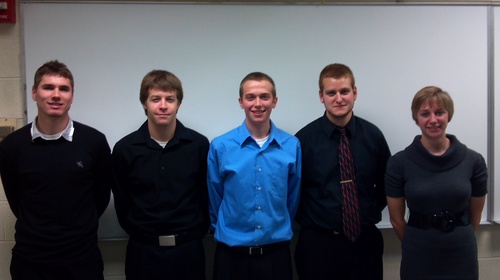

Team Entries
AutoShot
Designed by: Reid Carlson, Chan Soo Ha, Brian Janisch, Benjamin Lange, and Matthew Malecha
In all sports, improvement requires time and practice. Because of this, many aids have been invented and introduced in the past which improve practice efficiency. Today and throughout the history of the sport, soccer goalkeepers have practiced by having balls kicked at them by other players and practice for set plays such as free kicks and penalty kicks have required a good kicker for accurate practice. However accurate a single kicker may be, no human player can reconstruct the same kick over and over for repeated practice.The AutoShot addresses these setbacks by reproducing the same kick conditions – speed, height, and spin – repeatedly and at any set angle from different locations. This is achieved by having three degrees of motion across the pitch, yaw, and roll axes of our device. This design will then effectively simulate many different play situations such as set plays, and goalkeeper training. In addition, it allows the goalie to practice on their own or with the instruction of the coach.

EvacuPac
Designed by: Sam Bradley, Brent McCarthy, Matt Pezzino, Jeremiah Shafer, and Erik VanderSanden
Backpacking and hiking on long trips can be a fun but potentially dangerous activity. Both minor and major injuries can have serious consequences when far from civilization or rescue. One way to minimize this danger is to provide a way for fellow hikers to evacuate the injured person with ease. The external frame hiking backpack converts into a functional emergency stretcher. The EvacuPac Hiking Backpack is, comfortable, strong and performs both of its intended functions as well as or better than its standalone counterparts.
The Pendler
Designed by: Joseph Maloney, and Alex Cross
The Pendler is an all in one bike accessory solution for the urban commuter. Current market research shows that while many helpful commuter solutions exist for cyclists, they are common to most riders. This prompts the need for a combined solution which incorporates such accessories like a cargo rack, fenders, lights, and bags. The Pendler is durable yet aesthetically pleasing, handles high loads, and extreme weather conditions while selling at a reasonable cost and weighing little.
Reguflate
Designed by: Matthew Berggruen, Sean Kelly, Andrew Udelhoven, and Jordan Wall
Carbon dioxide tire inflation systems provide a means for biking enthusiasts to fill a deflated tire and get back on the road quickly. Existing tire inflators are limited in that they do not provide a way for the user to control the pressure in the bicycle tire. This leads to the user over or under inflating the tire, which can be hazardous to both the bicycle and the rider. The ReguFlate is a tire inflation system capable of accurately regulating the pressure delivered to the tire to eliminate these risks. The ReguFlate:- Delivers an accurate, user specified gas pressure to the tire.
- Accepts 12 gram unthreaded gas cartridges as well as 16 gram and larger threaded cartridges.
- Retains the pressurized content of partially spent cartridges.
- Mates with both Presta and Schrader tire fill valves.
- Continues to function correctly while being handled roughly.

Rotorak
Designed by: Jennifer Hull, Aaron Riedel, Alex Schwartz, Kelly Scott, Peter Sweeney
The Rotorak is a shelving system in which units can be rotated to allow ease of access to the shelves' contents. Preliminary work has been done to define a set of product design specifications (PDS) which will drive the design forward. Based on the PDS, an initial project baseline has been established in order to address each specification. The project baseline breaks down the Rotorak system into three separate subsystems. Within each subsystem is a set of requirements and interfaces that, once fulfilled, the system shall adhere to the original PDS.The three subsystems are Structure, Electro-mechanical Subsystem, and the Track Subsystem. The Structure is defined as the components supplying system strength and robustness, along with components used for aesthetic purposes. The Electro-mechanical subsystem is defined as components providing drive to the Rotorak (i.e. the motor) and the corresponding interfaces with the power source. Also, the user interface (i.e. the on/off switch) and its workings are incorporated into the Electro-mechanical Subsystem. The Track Subsystem is defined as all moving components involved in the motion and delivery of shelving units. This includes the sprockets, chain, belt, and the shelves themselves. The interface between shelving units and the track is also placed into the Track Subsystem.
In addition to the formulation of the PDS and the project baseline, a preliminary schedule has been made. The schedule highlights important milestones as well as dates for deliverables in order to reach said milestones. In addition to a detailed report on the system's PDS and project baseline, the following report describes the status and preliminary design work accomplished by Team Rotorak.

Silver Sorter
Designed by: Mitch Bayerl, Ben Crawford, Matt Hicks, and Meghan Linton
They will say, "50% of all marriages end in divorce" - and we hope to change that. Cutlery – mangled, dirty, and unsorted silverware – in condition enough, without any audacious marital detriment, to demand a solution. But hyperbole aside: the Cutlery Sorter will sort large volumes of washed or unwashed cutlery. Large kitchens wash as many as 2000 pieces of cutlery each hour, and spend $40.00 dollars doing so. Our sorter can: 1) sort 1 piece per second, 2) costs $10,000 to manufacture, and 3) sorts cutlery which conform – by visual inspection – to sanitary standards.
Truck Trolley
Designed by: Benjamin Butler, Matthew Dhennin, Brent Kocken, Matthew Mannebach, and Steven Wishau
The Truck Trolley is a new concept designed to assist users in transporting and lifting heavy objects with minimal risk of self-inflicted injuries. According to the Occupational Safety and Health Administration, 25% of all workplace injuries are heavy lifting related where 60% of those injuries are lower back injuries. This leads to a net loss in the United States of 12 million workdays and over $1 billion in compensation costs; Therefore, a more efficient and safer way to lift, load, and unload heavy objects must be examined. The design for the Truck Trolley is derived from two common products already on the market: the hospital gurney and the lifting cart. The Truck Trolley incorporates the ease of being able to set potentially large and heavy objects at near ground level, and boosting them up to a height above the bed of a truck. The trolley is then loaded by pushing the cart into the back of the user's vehicle while the legs supporting the trolley spring up into a resting folded position. The unloading process will be as simple as pulling the cart from the back of the vehicle, and the legs will descend to resume the original loading height. Hence, a design combining the best aspects of a hospital gurney and a lifting cart to drastically ease the process of lifting, loading, and unloading. The trolley fits in almost all standard sized trucks and moving vans. The Truck Trolley is also weather-proof, corrosion resistant, lightweight, durable and user friendly.
University of Wisconsin-Madison Department of Engineering Physics
Madison, Wisconsin
Revised: 12/13/2012